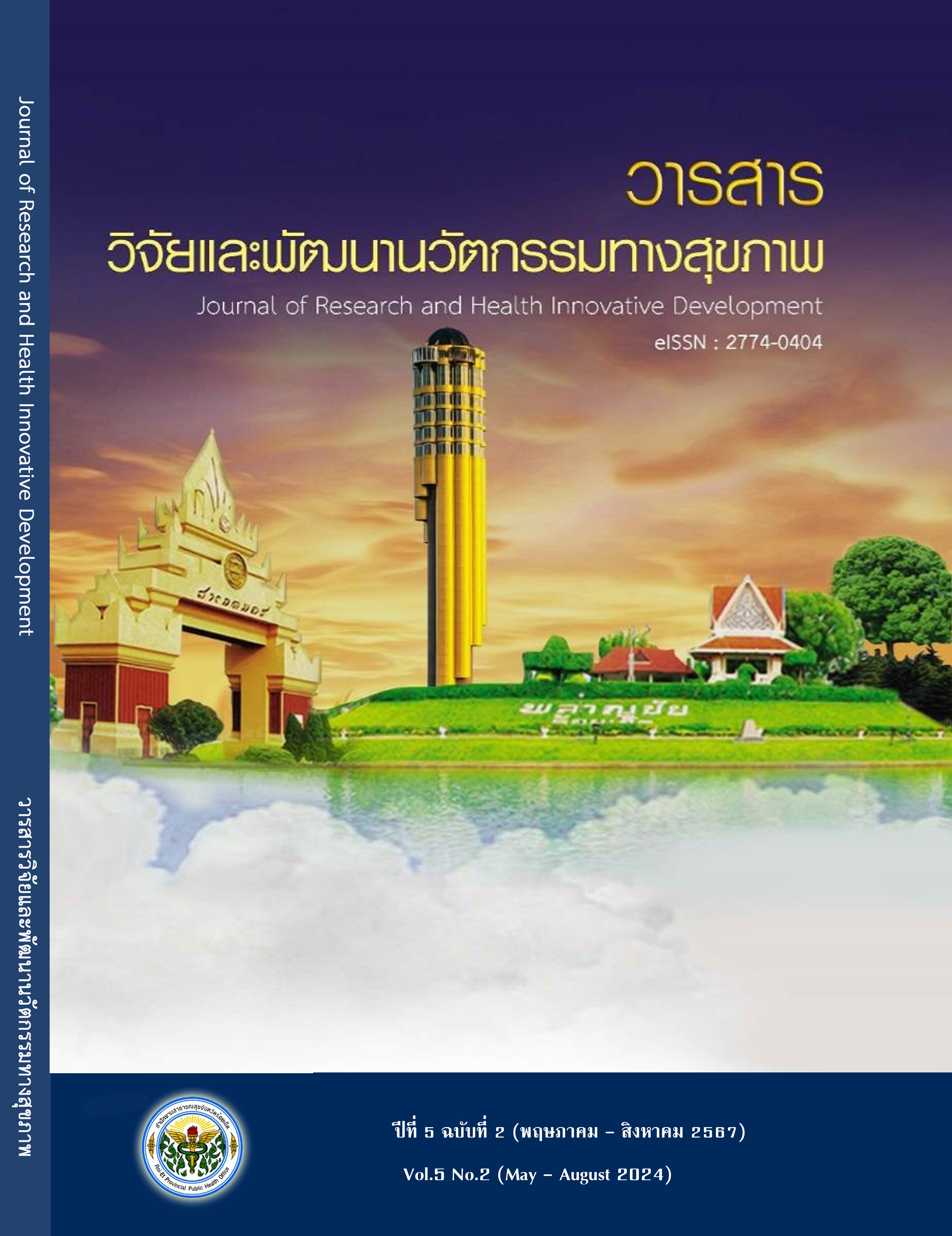The development of care models in Psychiatric Patients by Development Process of District Level Quality of life in Phonsawan District Nakhon Phanom Province
Keywords:
The development of care models in Psychiatric Patients, Psychiatric Patients, District Level Quality of lifeAbstract
Purposes : 1) To study the development of the model and evaluate the results of developing a model for caring for psychiatric patients through the district level quality of life development process, Phonsawan District, Nakhon Phanom Province.
Study design : Action Research.
Materials and Methods : By using purposive sampling, the participants consisted of 1) 21 people in the District Quality of Life Development Committee, Phonsawan District, 2) 35 people with Psychiatric Patients subcommittee, and 3) 621 people with Psychiatric Patients,Relative and Caregiver. There were 3 phases of research. Phase 1 analyzed the situation. Phase 2 improving the quality of life at the district level, Phase 3 evaluated the development of a care model in Psychiatric Patients Conducting research in Phonsawan District Nakhon Phanom Province. Questionnaire on the performance of roles and duties of the Quality of Life Development Committee satisfaction assessment form and the UCCARE process performance evaluation form. Data were analyzed using descriptive statistics t-test (One sample) statistics and a simple correlation analysis. The results showed that.
Main findings : There was a care system for Psychiatric Patients, CPG in care, Standard Operating Procedure of Phonsawan district and data linking, borrowing equipment and a fund has been established to help Psychiatric Patients Fundraising is organized in order to have a budget to help Psychiatric Patients. 1) Average scores for the roles of the committee and sub-committee on quality of life improvement at district level, each aspect and overall after system development higher than the expected threshold in all aspects with statistical significance at the .05 level. 2) Average scores for patient and caregiver satisfaction after system development side by side and overall above threshold expected, all aspects were statistically significant at the .05 level. 3) Roles of the Board and Sub-Committees on Individual and Overall Quality of Life Development have a relationship with a statistically significant UCCARE-based performance at .01 level.
Conclusion and recommendations : The use of guidelines for the continuous care of Psychiatric Patients should be promoted.
References
กรมสุขภาพจิต กระทรวงสาธารณสุข. รายงานประจำปี กรมสุขภาพจิต ปีงบประมาณ 2565. กรุงเทพฯ; 2565.
พรทิพย์ วชิรดิลก. ระบบการแพทย์ฉุกเฉินสำหรับผู้ป่วยฉุกเฉินจิตคลุ้มคลั่งแบบไร้รอยต่อและบูรณาการในประเทศไทย: การนำไปใช้และการติดตามประเมินผล ในพื้นที่นำร่อง. รายงานวิจัย. สถาบันการแพทย์ฉุกเฉินแห่งชาติ; 2564.
ศิริลักษณ์ ใจช่วง. ถอดบทเรียนการดำเนินงานพัฒนาคุณภาพชีวิต (พชอ.) จังหวัดนครพนม. เอกสารประกอบการประชุม. สำนักงานสาธารณสุขจังหวัดนครพนม; 2562.
เขตสุขภาพที่ 8. เอกสารประกอบการประชุมพัฒนาศักยภาพบุคลากรดำเนินงานพัฒนาคุณภาพชีวิตระดับอำเภอในเขตสุขภาพที่ 8; 2560.
รัศมี ชุดพิมาย. การพัฒนารูปแบบการดูแลผู้ป่วยจิตเวชเรื้อรังกลุ่มเสี่ยงในชุมชน ด้วยกระบวนการมีส่วนร่วมของภาคีเครือข่าย อำเภอลำปลายมาศ จังหวัดบุรีรัมย์. วารสารศูนย์อนามัยที่ 9. 256;16(3):851-67.
อนุพงศ์ ชาวคอนไชย, กัลยามาศ แจ่มกลาง. การบริหารจัดการเชิงระบบสู่การพัฒนาบริการสุขภาพจิตแบบ “ใกล้บ้าน ใกล้ใจในชุมชน” อำเภอโนนสูง จังหวัดนครราชสีมา. วารสารศูนย์อนามัยที่ 9. 2565;16(3):784-98.
Downloads
Published
How to Cite
Issue
Section
License

This work is licensed under a Creative Commons Attribution-NonCommercial-NoDerivatives 4.0 International License.
บทความที่ได้รับการตีพิมพ์เป็นลิขสิทธิ์ของ สำนักงานสาธารณสุขจังหวัดร้อยเอ็ด
บทความที่ลงตีพิมพ์ในวารสารวิจัย และพัฒนานวัตกรรมทางสุขภาพ สํานักงานสาธารณสุขจังหวัดร้อยเอ็ด ถือเป็น ผลงานวิชาการ งานวิจัย วิเคราะห์ ตลอดจนเป็นความเห็นส่วนตัวของผู้ประพันธ์ กองบรรณาธิการไม่จําเป็นต้องเห็น ด้วยเสมอไป และผู้ประพันธ์จะต้องรับผิดชอบต่อบทความของตนเอง


